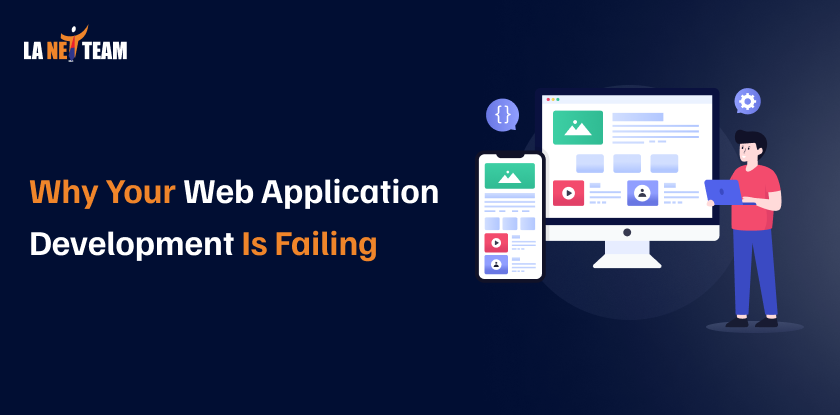Web apps are supposed to make work easier for businesses. BUT…. for many companies, it doesn’t turn out that way. Instead, users get stuck with a slow &confusing site that makes them disinterested.
In fact, as per a Forbes report, 88% of users don’t return to a site after a bad experience. That’s a HUGE LOSS for any businesses.
So what went wrong?
The problem usually starts when the WEB APPLICATION is not created properly as per the plan, and even the smallest issue leads to a huge problem.
For example, in 2017, Netflix faced major buffering and slow load issues. Because… its web app was not optimized properly for all devices.
Therefore, let’s learn how these problems can be solved and how to build an app that actually works like Netflix did.
What Is Web Application Development?
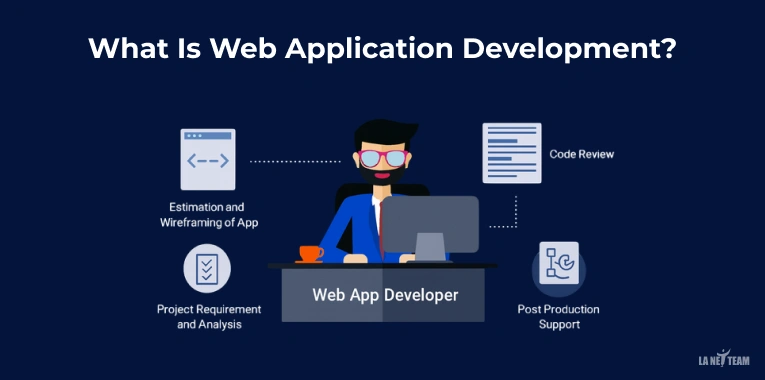
Web Application Development is the process of creating software that runs in web browsers. Such as Chrome, Safari, or Firefox.
Additionally, web applications allow users to perform specific tasks or to access services over the internet. For example, on regular websites, you just read information. Whereas, in Web applications, you get involved with interactive tools.
7 Types of Web Applications Every Developer Should Know
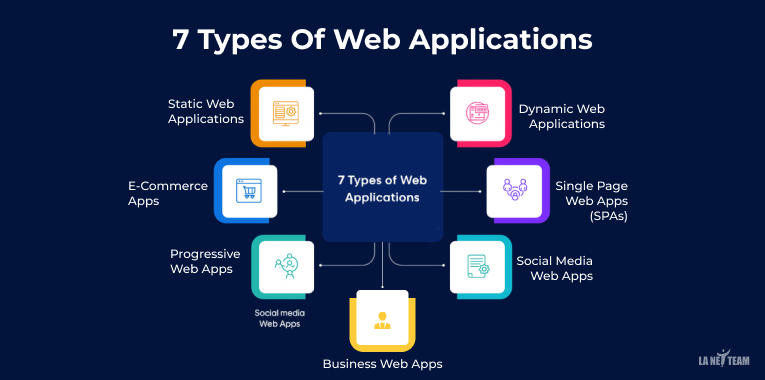
Web applications (or web apps) are of various types. Each type has its own purposes and user needs. By learning about these categories, you can find the correct fit for your project. Here are the correct main types:
1. Static Web Apps
A Static Web Application is the simplest type of web application. They display fixed content that doesn’t change unless the developer updates it manually.
It is built by using HTML, CSS, and JavaScript. This helps in providing the same information to every visitor.
Traits:
- No database or server-side processing
- Content remains the same for all the users
- Quick to load and easy to host
Example: A personal portfolio or a business website that showcases services.
2. Dynamic Web Apps
Dynamic Web Apps are more advanced than static web applications. This Type of web application generates content in real-time based on user interaction and their queries.
How it works: The app sends a request to the server, which processes it and sends a response back to the user in real-time.
Traits:
- Content changes based on user input or behavior
- Connected to databases for data storage and retrieval
- Server-side processing for each request
Example: Social media platforms like Facebook or Twitter, where the content changes based on user activity.
3. E-commerce Web Apps
E-commerce Web Apps are built for buying and selling products or services online. This type of web application handles everything from product browsing to secure payment processing and order management.
Traits:
- Secure payment gateway integration
- Order tracking and management systems
- User account and purchase history
- Product catalogs with search and filtering
Example: Amazon, Shopify stores, Online marketplaces
4. Single Page Web Apps (SPAs)
Single-page Web Apps are a combination of mobile apps and web apps. They work like mobile apps but run in a browser.
This type of web application is built with modern JavaScript frameworks like React, Angular, or Vue.js.
Traits:
- Fast and responsive user experience
- Content updates without full page reloads
- Reduced server load after initial load
- Feels more like a desktop or mobile app
Example: Gmail, Google Maps, Trello, Netflix
5. Progressive Web Apps (PWAs)
Progressive Web apps are a combination of the best features of websites and native mobile apps. This web application works through a web browser but can be installed on devices and functions offline.
Traits:
- Installable on mobile and desktop devices
- Work offline or with poor connectivity
- Send push notifications
- Cross-platform compatibility (works on any device)
- No app store approval needed
Example: Twitter Lite, Pinterest, Spotify Web Player, Starbucks ordering app
6. Social media Web Apps
Social media web apps are built for communication and sharing. They let users create accounts, connect with friends, and share posts.
Traits:
- Centralized access to various tools and information
- User authentication and personalized dashboards
- Integration with multiple systems
- Role-based access control
Example: Instagram, LinkedIn, TikTok (Web versions)
7. Business Web Apps
Business Web Apps are built to help companies run smoothly. Their motive is to focus on automation, data management, or customer support.
Example: Centripe (CRM) for customer management, or SAP (ERP) for managing business operations
Web Apps vs Mobile Apps: Which is Better for Your Business?
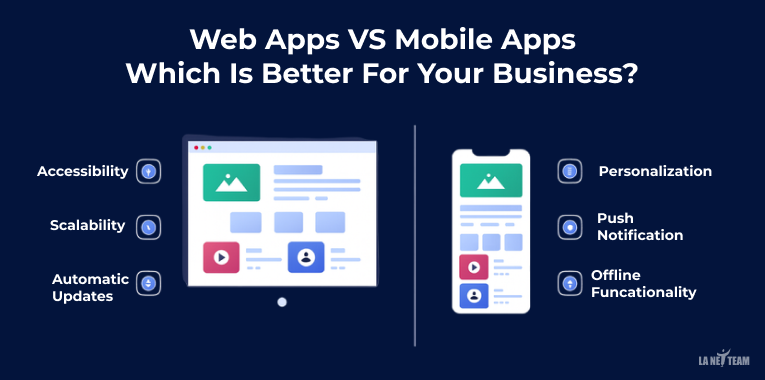
| Factor | Web Apps | Mobile Apps |
|---|---|---|
| Development cost | $15,000 – $80,000 | $50,000 – $300,000+ (per platform) |
| Time to market | 2-4 months | 4-9 months |
| Platform Coverage | Works everywhere | Separate builds for iOS/Android |
| User Access | Just Type URL- no download needed | Must download from the app store |
| Offline Functionality | Limited | Full offline capabilities |
| Performance speed | Good, depends on the connection | Excellent, optimized for the device |
| Device Features | Limited Access | Full Access |
| Updates | Get instant updates | Requires approval to see updates |
| Discovery | Found through search engines | Found in app stores |
| Maintenance Cost | Lower | Higher |
The right choice between a web app and a mobile app… depends on your business needs, target audience, and goals.
But for more clearer decision, if you need broad accessibility and lower development costs, a web app is the best choice.
But if you’re looking for more personalized user experiences and offline functionality, a mobile app could be your best bet. Whatever you choose, focus on delivering value, ease of use, and a seamless experience for your users.
5 Common Mistakes In Web App Development & How to Avoid Them
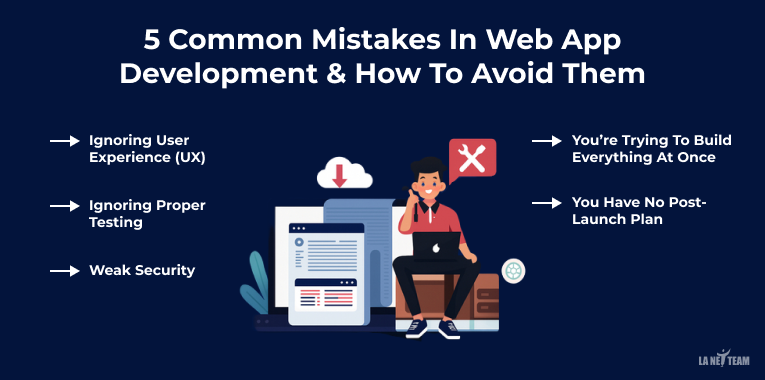
Mistake 1: Ignoring User Experience (UX)
One of the biggest mistakes that we overlook is focusing only on features and not on the people who will use the app.
What does this look like:
- Complicated navigation
- Inconsistent design
- Slow loading speed
- Poor mobile experience
How to fix it:
- Do user research before writing the final code.
- Test the app earlier, and not just at the end.
- Create user personas and journey maps to understand how people will use the apps.
Mistake 2: You’re trying to build everything at once
You want your app packed with every feature in just three months. Features such as payment processing, an admin panel, an analytics dashboard, etc.
But that’s too much to expect in just 3 months. Your team might get stressed and would not perform well, and end up with an improperly built app.
What does this look like:
- Nothing feels quite finished or polished.
- Each new feature breaks something that was working.
- Testing reveals dozens of broken features.
How to fix it:
- Set a realistic launch date.
- Identify your core value proposition.
- Create a feature priority matrix.
- Launch with 20% of planned features.
Mistake 3: Ignoring proper testing
Many companies make the mistake of ignoring proper testing. They often ignore testing and launch their software.
Did you know: The U.S. loses $59.5 billion each year because of poor software testing.
What does this look like:
- Bugs in core features
- The app works on one browser but breaks on another
- Users lose trust after repeated crashes
How to fix it:
- Do four levels of testing: unit, integration, system, and user acceptance.
- Use an automation tool to save time
- Run a beta test with real users to catch issues.
Mistake 4: Weak Security
Cyberattacks are growing every year. In fact, as per the report of IBM, the average cost of a data breach is now $4.45 million. Yet many apps are still built with weak security.
What does this look like-
- Weak logins or no two-factor authentication.
- No encryption of sensitive data.
- Poor protection against hacks like SQL injection or XSS.
How to fix it:
- Add strong authentication and data encryption from day one.
- Follow OWASP Top 10 guidelines (a trusted security standard).
- Do regular security testing and audits.
- Keep your app updated to block new threats.
Mistake 5: You have no Post-launch Plan
Most of the companies just focus on and spend their energy on reaching the launch day. But once the app goes live, and no user shows up, you don’t have any further plan to deal with it.
What does it look like-
- Traffic that never materializes.
- The app is empty as there’s no user engagement.
- Have zero marketing budget.
- No plan for customer acquisition.
How to fix it:
Plan your launch and ongoing growth before you finish building.
- Build an email list pre-launch
- Create a launch marketing plan
- Have a support plan
- Set up analytics and feedback loops
Conclusion
The actual issue occurs when companies take a shortcut in the process without considering the individuals who will be the real users of their application.
Let’s understand it with an example, when you cook, you can’t put every ingredient in the pot at once and expect it to be a great meal.
Even Netflix made the same mistake and learned and over their mistakes by following the above solutions. Your app doesn’t need to be perfect at first, but it should work well and solve users problem. Therefore, keep it simple, listen and understand users needs, and build something they’ll want to come back to.
